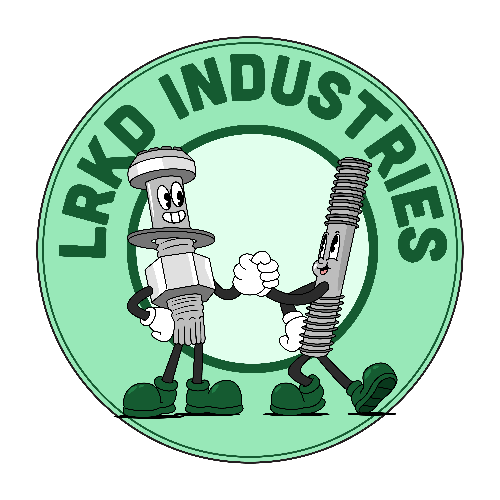Imagine the towering strength of a skyscraper or the resilience of a bridge. What keeps these colossal structures anchored to their foundations? One crucial yet often underestimated component is the bent anchor bolt. While its significance might go unnoticed, its role in maintaining structural integrity is paramount.
For engineers, architects, and construction professionals, understanding the bent anchor bolt process isn’t just advisable—it’s essential. Let’s dive into this fascinating topic and uncover the intricacies of creating reliable anchor bolts.
An often-overlooked aspect of anchor bolt manufacturing is the bending of a hooked bolt. While there are several methods to accomplish this, special attention is required when using a press brake.
At LRKD Industries, we manufacture all anchor bolts to meet ASTM Specification F1554. This specification provides comprehensive guidelines to ensure the bolts meet or exceed engineering requirements. However, when it comes to bending, F1554 does not specify a particular method
What Are Bent Anchor Bolts?
Bent anchor bolts are L-shaped or J-shaped fasteners embedded in concrete to secure structures like columns, machinery, or towers. Their bent design provides additional resistance to forces such as tension and uplift, ensuring stability even under dynamic loads.
Key specifications include:
-
Material: Typically steel, compliant with ASTM standards like F1554.
-
Design: Includes straight and hooked layouts, depending on the application.
-
Usage: Commonly found in industrial, commercial, and infrastructural projects.
The Importance of the Bending Process
The bending process defines the anchor bolt’s reliability and performance. A poorly executed bend can compromise the bolt’s strength, leading to potential failure under stress. To ensure safety and durability, the following principles must be adhered to:
1. ASTM F1554 Specification
ASTM F1554 sets the standard for anchor bolt manufacturing. While it provides guidelines for dimensions and materials, it lacks explicit instructions for bending methods. Section 10.3 highlights:
-
The bent section must retain at least 90% of the cross-sectional area of straight portions.
-
Bends should be uniform to prevent weak points.
2. Mandrel Bending
The recommended method for bending anchor bolts involves a mandrel:
-
Consistent Pressure: Ensures uniform curvature without weakening the material.
-
Correct Diameter: Prevents dents or impressions that could concentrate stress.
Example: A 1-1/2” diameter Grade 55 round bar was bent around a perfectly circular 3” diameter mandrel, resulting in a hook with an inside radius of 1-1/2”. The shiny area indicates where the mill scale was removed due to contact, but there is no distinct location where an impression is concentrated.
To grasp the significance of this, consider the interaction between the column, base plate, and anchor bolts (see above image). When a column is positioned and the base plate is secured, any movement at the top of the column generates uplift pressure (energy) on the anchor bolts, as illustrated. For a properly bent anchor bolt, this energy is distributed along the inner radius of the hook.
3. Avoiding Press Brake Methods
Press brake bending, though common, poses risks:
-
Leaves dents or impressions.
-
Focuses stress on specific points, increasing failure likelihood.
Using a mandrel that is too narrow or pointed for bending can cause a dent at the contact point. In an uplift scenario, this concentrates all the energy on that area, greatly increasing the likelihood of failure.
Figure 2, illustrates the stress concentrated at the dented area. In contrast, Figure 3, depicting a uniform bend formed around a properly sized round mandrel, demonstrates even stress distribution.
The Brooklyn Bridge Renovation
A notable example of proper bent anchor bolt usage is the Brooklyn Bridge’s renovation in the early 2000s. Engineers faced challenges in securing new structural elements to the existing foundation. Using ASTM F1554 Grade 55 bent anchor bolts, meticulously manufactured around appropriately sized mandrels, they ensured:
-
Even stress distribution across the bolts.
-
Enhanced stability under dynamic loads.
-
Long-term durability for this iconic structure.
This project underscored the importance of precision and adherence to standards in anchor bolt manufacturing.
Actionable Tips for Construction Professionals
Whether you’re an engineer, contractor, or architect, consider these tips when working with bent anchor bolts:
-
Specify Standards: Always require compliance with ASTM F1554 in project specifications.
-
Inspect the Bend: Ensure bolts show no dents or impressions at the bend radius.
-
Collaborate with Experts: Partner with manufacturers like LRKD Industries, renowned for their precision and quality.
-
Understand Stress Dynamics: Visualize how anchor bolts interact with base plates and structures under load.
The bent anchor bolt process is a cornerstone of modern construction, blending engineering precision with practical application. From understanding ASTM standards to leveraging proper bending techniques, professionals can ensure structural safety and longevity. As you plan your next project, consider the foundational role of anchor bolts—and make informed choices to build with confidence.
Bent Anchor Bolt Process
Save your detailers some time! Whether it's for a bid or an existing project, we're here to help you navigate the bent anchor bolt process with precision. From interpreting your drawings to ensuring correct bend dimensions and thread specifications, our team ensures you receive exactly what your project needs—on time and without the guesswork.
This service is ideal for engineering and construction teams who need fast, accurate material evaluation and bolt fabrication planning without the manual strain.
Contact LRKD Industries now to streamline your anchor bolt workflow!
👉 Submit your plans today for a FREE consultation and bent anchor bolt evaluation.
📍 Address: 98 N Industry CT, Deer Park, NY 11729, US
📞 Phone: +1 646-880-6778
📧 Email: info@lrkdindustries.com
We can also convert your files into “.dwg” format compatible with Tekla, allowing for seamless integration with your 3D modeling and fabrication systems.
Click here to learn more about our anchor bolt products.
When every bend and thread matters, precision isn’t optional—it’s essential.


